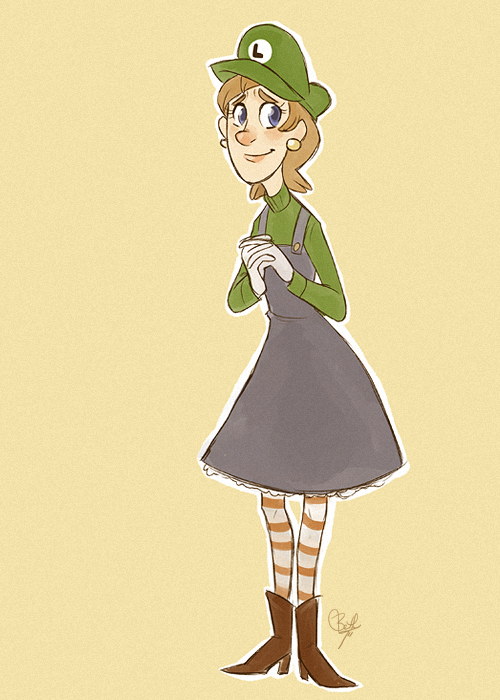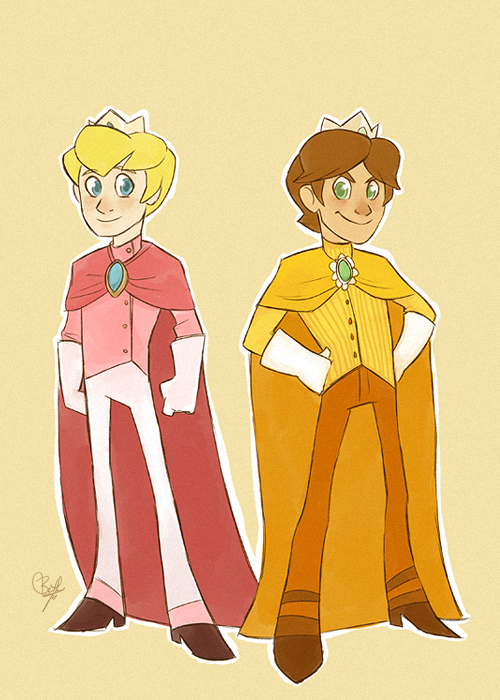 (You may want to check out the part I and part II beforehand,)
(You may want to check out the part I and part II beforehand,)"So, to sum up: there are different reasons why I intentionally deviate from the default model when playing videogames. First off, this has to do with identification. Most lead characters are white, muscular and above all: aggressive male. These characteristics shape the stereotypical ‘tough guy’ standard which features prominently in many video gaming adventures. To my taste, such ‘hypermasculinity’ – as if I were playing with a walking steroid – is not the type of hero I could recognize myself in nor want to play with, despite sharing a lot of overall features with this masculine and Caucasian default. On the contrary: I would prefer the more ‘in-depth’ characters that are known for their interesting stories or personality rather than their looks and so called ‘manliness’. Nah, I’d settle for someone that would act more like me instead of just matching some of my looks.
Secondly, even though colored male characters are seen more and more in videogames these days, they are still being a minority in regards to the white norm; not to mention the equally important underrepresentation of female models. And to make things worse: the women that do feature in such interactive adventures are too often limited to another cliché: that of the ‘sexy heroine’. Thus, despite that diversity in characters is slowly slipping through more and more, the options we as gamers get offered nowadays are still too damn restricted. And on a symbolic level, that means a lot, for the current sexist and racist standards reproduce the inherent message that certain roles are not ‘supposed’ to be played by characters with a specific gender or racial background. Representation is definitely an important factor in need of improvement. The easiest way to challenge the current harmful standard is by deviating from that norm whenever possible; to cherish the opportunity for change if the game offers even the smallest mode of ‘personalization’.
Thirdly, I choose variety in my gaming experiences merely for the sake of variety itself – to see what could *also* be a way to play an adventure. For instance, to grab back to the Mass Effect example: changing the gender of my hero(ine) goes hand in hand with switching to another voice actor, meaning that the story will be experienced differently, as each of two actors does a different job to it – despite having the same lines to perform. Both have their own style of adding life to the Shepard-character, for that is all voice acting is about. Furthermore, going with a different skin color and other bodily features than my own makes me, the gamer itself, look differently at the game as a whole. It makes me able to approach the adventure and interactions with other character ‘through a different lens’. Even though the voice acting will still be done by the same person that delivers the lines to the ‘white’ Shepard, throughout my whole 40-hour-long-gameplay do I get to look at and identify with a protagonist of color (if I chose one of the variations on this racial spectrum). Not only does this experience teach me that epic adventures are open to anyone and not just the Caucasian-looking ‘tough guy’ standard; it also makes me more susceptible to look at the racial background of the other non-playable characters in the game besides my own. ‘Becoming a character of color’ (instead of white, as is the norm) makes me question the lack of representation of colored characters in that game as a whole, as I constantly get reminded by ‘my’ looks what is otherwise not included or at least misrepresented. In other words: changing the racial identity or gender of the protagonist makes me aware of the privileges of playing with the ‘white guy’ model, as this is still the unquestioned standard in most games. Thus, by intentionally seeking more variety I get to think critically about my own position and how standardized ‘my own identities’ are, for now I become more alert of the ‘normative’ and the ‘deviant’; it makes me question why these are the norms in the first place.
Concluding: emphasizing variety in gender and racial identity is at this point still needed to show the structural lack thereof. Ironically, to ‘make aware’ that inclusion of all kinds of humans is still limited and no equal representation has been achieved yet, the current differences need to be pointed out exactly because of such existing lack - as it then becomes a sort of ‘in your face’-message. I know that I for one took a long time to realize that so many games I played were exclusively targeted at me and people like myself that fitted a limited gender- and racial-category. Because of having the privilege of being part of the norm I did not realize how alternatives to this sexist and racist standard are underrepresented. Therefore, by playing with different kinds of characters – different in many ways, not only in regards to gender or racial features – I hope to become better alert to able to speak out against such structural racism; as that is what lack of inclusion and underrepresentation is all about. And I can tell is that actively ‘adjusting’ my in-game looks hasn’t been a bad decision at all – rather the opposite. So I am expanding my gaming experiences by trying to identify with a different protagonist than the usual white ‘tough guy’ model, while at the same time seeing my own privileged identities in video game land being emphasized and therefore questioned? There seems to be no more enjoyable way to make me learn of the current sexist and racist standards in videogames and use this ‘experienced knowledge’ to share with other than by doing – by literally ‘gaming to differ’.
For as we have seen with the Mass Effect example: if only enough of the gamers themselves raise their voice and share their issues with the default norm, can change on a more individual level lead to improvement on a larger scale in the end. And that’s exactly why I deliberately choose to play with a character I am ‘not supposed to’: simply because I get to identify with a model that looks different from myself, I get made more aware of what is *also* among the possibilities that are not part of the privileged norms. Something which is beneficial to me as well, as that deliberate choice for variety is exactly what turns out to add more and more depth and pleasure to my videogame experiences compared to sticking to the default choices. Only by playing with a female heroine, character of color or choosing for the protagonist to develop a same-sex relationship, which would usually not be the standard option, does this underrepresentation and problem of non-inclusion get emphasized. Turns out I need to get ‘embedded’ with the minority identities in games to question my own prevalent privileges, for otherwise I would not have known. Now talk about irony."
The genderswapped Super Mario characters are done by Rolling Rabbit, we found them too cute not to be posted as illustrations for this topic.
Daryo is one of those people that enjoys playing videogames and has a mind set at reflecting on things with 'feminist glasses' on, hence the love for Gender and Sexuality Studies.



No comments:
Post a Comment